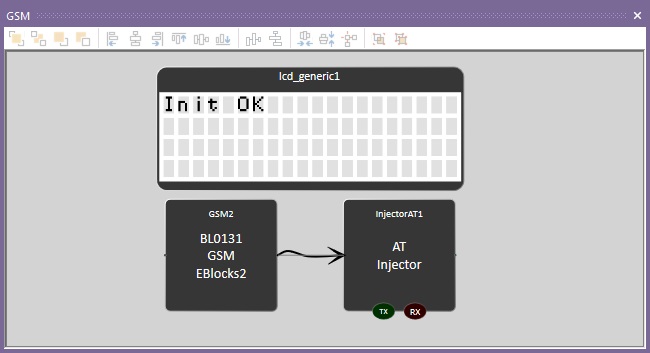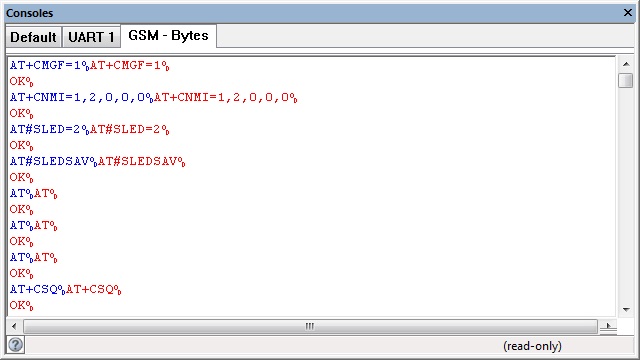Component: GSM (EB066, Generic AT) (Wireless)
| Author | Matrix Ltd. |
| Version | 1.3 (Release) |
| Category | Wireless |
Contents
 GSM (EB066, Generic AT) component
GSM (EB066, Generic AT) component
Low level routines for controlling a standard AT GSM / GPRS interface Also available in the form of the EB066 GSM E-block.
Examples
Example should show the following on the display on the panel and on the hardware.
The AT injector component allows us to simulate the response of the GSM module.
Downloadable macro reference
DialNumber
Performs a standard voice call by dialling the number specified.
Returns 0 for call in progress and 255 for no response.
Parameters
- <- STRING Number
- This parameter may be returned back to the caller
Return value
GetTextString
Collects the text message data from an incoming text message.
Parameters
- BYTE NumBytes
Return value
SendScript
Send an AT command script.
Returns 0 for fail, 1 for success and 255 for unrecognised script idx.
Parameters
- BYTE idx
Return value
AnswerIncomingCall
Answers the phone for an incoming type call.
Returns 0 for success and 255 for failure.
Parameters
- This macro has no parameters
Return value
SendCommand
Sends a command string to the GSM module.
0 = Command sent ok, 255 = No Reply
Parameters
- <- STRING Command
- This parameter may be returned back to the caller
- BYTE SendCR
Return value
GetTextNumber
Collects the sender's phone number from an incoming text message.
Parameters
- BYTE NumBytes
Return value
HangUpCall
Ends a voice based call.
Returns 0 for success and 255 for failure.
Parameters
- This macro has no parameters
Return value
ReadString
Copies the data from the data string array to a local string variable
Parameters
- BYTE NumBytes
Return value
SendTextMessage
Sends the text message data specified to the number specified using the SMS protocol.
Returns 0 for success and 255 for failure.
Parameters
- <- STRING Number
- This parameter may be returned back to the caller
- <- STRING Message
- This parameter may be returned back to the caller
Return value
StringReceive
Attempts to receive a string from the GSM modem.
Parameters
- This macro has no parameters
Return value
CheckNetworkStatus
Returns the state of the GSM network.
0 = Not connected, 1 = connected, 255 = no reply from GSM.
Parameters
- This macro has no parameters
Return value
CheckForIncoming
Checks to see if any incoming phone call or SMS message.
0 = Nothing, 1 = Text Received, 2 = Phone Ringing
Parameters
- This macro has no parameters
Return value
Initialise
Sets up the GSM module.
Returns 0 for OK, 255 for no reply and 254 for command fail.
Parameters
- This macro has no parameters
Return value
Simulation macro reference
This component does not contain any simulation macros
Property reference
Expect Echo
This property is of type True or false and can be referenced with the variable name expect_echo.
Sets if we expect an echo of any data we send out to the GSM modem.
Most AT type modems (e.g. GSM modules) will automatically echo back incoming data.
String Array Size
This property is of type Signed integer and can be referenced with the variable name string_size.
Amount of RAM memory to dedicate to receiving responces from the GSM
Message Array Size
This property is of type Signed integer and can be referenced with the variable name message_size.
Amount of RAM memory to dedicate to storing the last SMS message received by the GSM.
Baud Rate
This property is of type Fixed list of ints and can be referenced with the variable name baud.
Theoretical number of digital bits that can be send or received a second.
Theoretical because it is unlikely you will be constantly sending or receiving data 100% of the time.
Flow Control
This property is of type True or false and can be referenced with the variable name flow_control.
When enabled adds two extra pins to help control the flow of data between the device and the remote device.
Script Count
This property is of type Fixed list of ints and can be referenced with the variable name script_count.
Maximum number of scripts to store in the device's ROM
Script1
This property is of type Multiple lines of text and can be referenced with the variable name script1.
ASCII based AT command data stored in ROM and used when sending script 1
Channel
This property is of type Fixed list of ints and can be referenced with the variable name channel.
Onboard UART peripheral to use to perform serial commands.
Software mode not available as code currently requires hardware receive interrupt in order to work correctly.
TX Pin
This property is of type Single digital pin and can be referenced with the variable name tx_pin.
UART Transmit Pin
RX Pin
This property is of type Single digital pin and can be referenced with the variable name rx_pin.
UART Receive Pin
Label
This property is of type Line of text and can be referenced with the variable name label.
Textual label shown on the component I/O flasher
Injector
This property is of type Fixed list of ints and can be referenced with the variable name Injector.
No additional information

